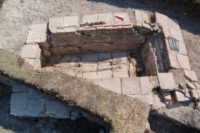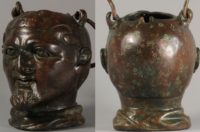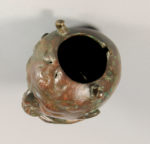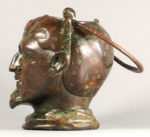A unique brass vessel in the shape of a man’s head has been discovered in a Roman-era grave in Bulgaria. The grave was discove red in the Kral Mezar tumulus near the village of Boyanovo in southeastern Bulgaria. The tumulus had been repeatedly looted over the centuries and agricultural activity had altered its shape and size, so a salvage archaeology mission was undertaken in 2015 to excavate it thoroughly.
red in the Kral Mezar tumulus near the village of Boyanovo in southeastern Bulgaria. The tumulus had been repeatedly looted over the centuries and agricultural activity had altered its shape and size, so a salvage archaeology mission was undertaken in 2015 to excavate it thoroughly.
Inside the tumulus archaeologists discovered three burials — a sarcophagus, a brick grave and a tomb. The limestone sarcophagus with a pitched roof lid (found broken on the side) dates to around 150-200 A.D. Sarcophagi are rare finds in Roman Thrace and are believed to have contained the remains of non-Thracians. The tomb was built of stone and brick with plastered and painted interior walls. It was heavily looted, but the extant funerary goods include bone spindles, needles, glass beads, glass and ceramic fragments and clay lamp fragments. A silver denarius from the reign of Caracalla minted in 202 A.D. was found on the tomb floor. Because of the textile-making grave goods, archaeologists believe this was a woman’s tomb.
But it was the third burial, the brick grave, that contained a truly striking artifact. The rectangular pit was lined with bricks coated with a thick layer of white plaster. Marks on top of the brick walls indicate there had once been wooden beams across the top forming a flat roof. This type of grave was popular in Roman Thrace, particularly in the 2nd and 3rd centuries.
 The body had been placed in a wooden coffin of which only a few iron nails survive. The skeletal remains are still articulated and just shy of six feet long (1.82 meters). Osteological analysis found the deceased was an adult male about 35-40 years old at time of death. Inside the grave was a bronze coin of Caracalla minted in Hadrianopolis 198-217 A.D., fragments from a glass flask, the remains of two pairs of hobnailed shoes, a balsamarium and a strigil.
The body had been placed in a wooden coffin of which only a few iron nails survive. The skeletal remains are still articulated and just shy of six feet long (1.82 meters). Osteological analysis found the deceased was an adult male about 35-40 years old at time of death. Inside the grave was a bronze coin of Caracalla minted in Hadrianopolis 198-217 A.D., fragments from a glass flask, the remains of two pairs of hobnailed shoes, a balsamarium and a strigil.
“In our opinion, the grave belongs to a Thracian aristocrat, who has practiced sport in his everyday life, rather than to a professional athlete,” Daniela Agre, an archaeologist at the National Archaeological Institute with Museum at the Bulgarian Academy of Sciences, who led archaeological work at the site, told Live Science. […]
“We think that the tumulus was used as a family necropolis and the deceased was a part of this family,” Agre said.
The strigil is brass, of a type found in other Bulgarian graves from the 2nd and 3rd centuries. The balsamarium is also brass, but it is far from a type seen in other Bulgarian graves of the period. In fact, it is unique in the archaeological record of Roman Thrace.
This type of container is believed to have been used to hold scented oils or perfumes for use in the baths, which is why they’re often found coupled with strigils which would have scraped the oil off the skin to clean and exfoliate.
 It is 4.7 inches high, 4.2 inches wide and is shaped like the head of man wearing an animal-skin skullcap. The visible features of the animal’s head — nostrils, eyes, canine teeth in the lower jaw — suggest it was a feline. A neck draped with robes forms the foot of the vessel with a flat bottom made from a single metal sheet. There’s a hole in the top of the head for a hinged lid that is now lost. On either side of the opening are loops where a swing handle was attached. There’s still a handle attached through one of the loops; the other side of the handle is broken.
It is 4.7 inches high, 4.2 inches wide and is shaped like the head of man wearing an animal-skin skullcap. The visible features of the animal’s head — nostrils, eyes, canine teeth in the lower jaw — suggest it was a feline. A neck draped with robes forms the foot of the vessel with a flat bottom made from a single metal sheet. There’s a hole in the top of the head for a hinged lid that is now lost. On either side of the opening are loops where a swing handle was attached. There’s still a handle attached through one of the loops; the other side of the handle is broken.
The man’s face is broad with shaved cheeks and a neatly shaped goatee. His nose viewed from profile has a proud aquiline bump. Seen from the front, it is bent to the left and widened at the base, suggesting that it has seen the business end of more than a few clenched fists. Five vessels with comparable features are found in museums in Los Angeles, France and  Germany. Scholars believe these features — the bent aquiline nose, the goatee, the skullcaps, the lock of hair on the back of the head — represent the heads of boxers or wrestlers. The Boyanovo piece is distinct from these comparables because it does not have the lock of hair and because of its feline skin cap. The former is likely necessitated by the latter; the sculptor couldn’t include both the lock of hair and the incredibly detailed feline skin covering the back of the hair.
Germany. Scholars believe these features — the bent aquiline nose, the goatee, the skullcaps, the lock of hair on the back of the head — represent the heads of boxers or wrestlers. The Boyanovo piece is distinct from these comparables because it does not have the lock of hair and because of its feline skin cap. The former is likely necessitated by the latter; the sculptor couldn’t include both the lock of hair and the incredibly detailed feline skin covering the back of the hair.
The find has been published in the latest issue of the American Journal of Archaeology and can be downloaded here.
Obviously in contrast to the ‘lid’, (in this case) the ‘lynx’ is still there. We can only speculate on why it was considered adequate to wear a cat-cap, as poaching has become one of the biggest threats to the survival of the Balkan subspecies of the European lynx. Is it just me, or does the wearer appear to have received a blow to his nose and his left cheekbone (by a blade or -maybe- feline claw?).
Thra(e)x, Θρᾷξ (or ‘Thracian’) was an important subspecies of the ‘Common Roman Gladiator’. Common practice in neighboring Skythia was to take scalps: “They take off the skin of the head by cutting it round at the ears and then, taking hold of the scalp and shaking it off” – ..ἀποδείρει δὲ αὐτὴν τρόπῳ τοιῷδε· περιταμὼν κύκλῳ περὶ τὰ ὦτα καὶ λαβόμενος τῆς κεφαλῆς ἐκσείει.. (Advertisment: Buy poacher caps!)